There was a time when choosing the best circular saw simply meant picking your favorite or most trusted brand. Now there are so many choices it can make your head spin. Corded or cordless? Sidewinder or worm drive? Left blade or right blade?
Whether you’re looking for the best professional circular saw or budget-friendly options, we have your back!
Before we dive in too far, let’s talk about power sources. Years ago, cordless circular saws struggled in performance, and it took them a while before they were effective with a 7 1/4-inch blade. Now, cordless models can outperform their corded counterparts. Between that and the convenience of not having a cord, they really are the best circular saws you can get. However, corded models are still far less expensive and are most definitely effective. The point is that since we’re talking about the best, we’re leaning heavily on cordless power sources.
Out Best Circular Saw Top Picks
- Best Cordless: Metabo HPT 36V C3607DA – Buy on Amazon
Jump to this Circular Saw ↓ - Best Corded: Metabo HPT RipMax Pro Series – Buy from Acme Tools
Jump to this Circular Saw ↓ - Best Worm Drive: Flex 24V Rear-Handle FX2141R – Buy from Acme Tools
Jump to this Circular Saw ↓ - Best for Metal: Milwaukee M18 Fuel 2982 – Buy from Acme Tools
Jump to this Circular Saw ↓ - Best Compact: Flex 24V 6 1/2-Inch Inline FX2131A – Buy from Acme Tools
Jump to this Circular Saw ↓ - Best Mini: Milwaukee M12 Fuel 5 3/8-Inch 2530 – Buy from Acme Tools
Jump to this Circular Saw ↓ - Best for the Money: Skilsaw SPT67WL/SPT67WM – Buy from Acme Tools
Jump to this Circular Saw ↓ - Best for Beginners: Skilsaw SPT67WE-01 – Buy from Acme Tools
Jump to this Circular Saw ↓
Also in this Article
- Best Circular Saw Blades
- Best-Selling Circular Saws from Top Retailers
- More Recommendations for Pros
- More Recommendations for Prosumers
- More Recommendations for DIYers
- What is a Circular Saw Used For?
- What to Look for When Buying a Circular Saw
- Why You Can Trust Pro Tool Reviews
Want more cordless options? Check out our Best Cordless Circular Saw recommendations!
Best Cordless Circular Saw Overall
Metabo HPT MultiVolt Circular Saw
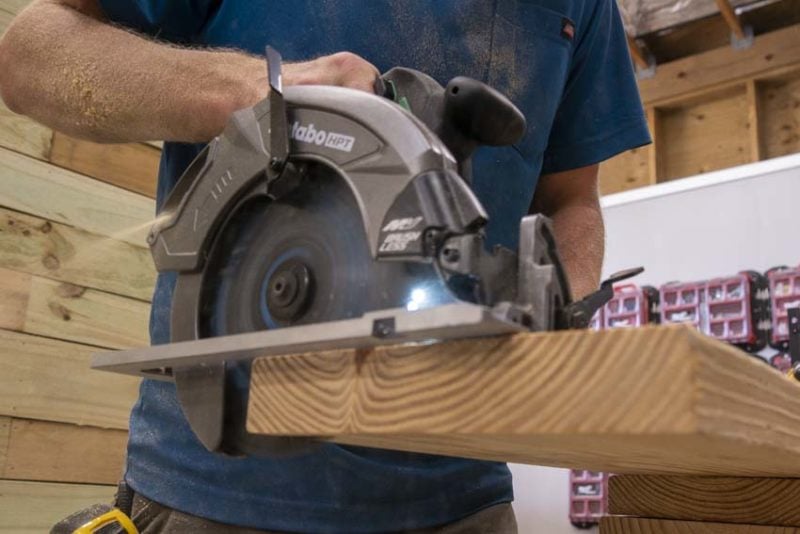
The Metabo HPT MultiVolt circular saw rises above the rest of the competition as our pick for the best cordless circular saw, finishing just ahead of Milwaukee’s M18 Fuel 2732. It has remarkable power and accuracy, even compared to DeWalt, Makita, and Milwaukee.
It’s also lightweight compared to its closest competition. Using a 4.0Ah battery, the total working weight is just 9.7 pounds. Plus, it’s the only cordless sidewinder-style saw that has an AC adapter to give you the unlimited runtime of a cord.
If there’s a downside, it’s that the main and front handles are a little too close for some of our crew’s taste.
Price: $139 bare tool
Best Corded Circular Saw Overall
Metabo HPT RipMax Pro Series
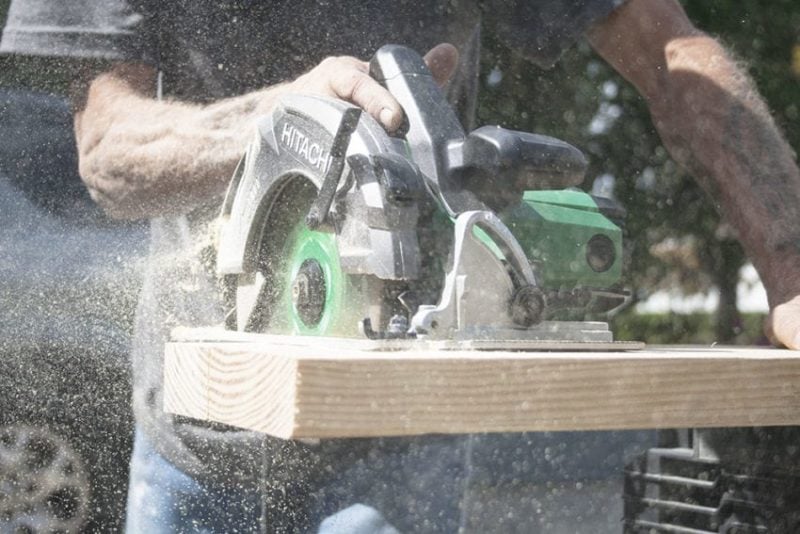
The RipMax line of circular saws was launched before Hitachi rebranded to Metabo HPT. The C7UR and C7URM hit the market hard, bringing some of the best cutting speeds our Pros have seen in the field. At 6800 RPM, it passed our field testing with flying colors and our framing crew raved about how much faster it could cut.
Metabo HPT brackets your needs well with the RipMax line. The C7UR is the base model and is a little tougher to find. Amazon usually has some in stock, though. The CR7URM drops the weight a bit with magnesium in the build. The CR7BUR is the top of the line, adding an electric brake and making it the top choice for Pros.
Price: $140.99
Best Worm Drive/Rear-Handle Circular Saw
Flex 24V Brushless Rear-Handle Circular Saw
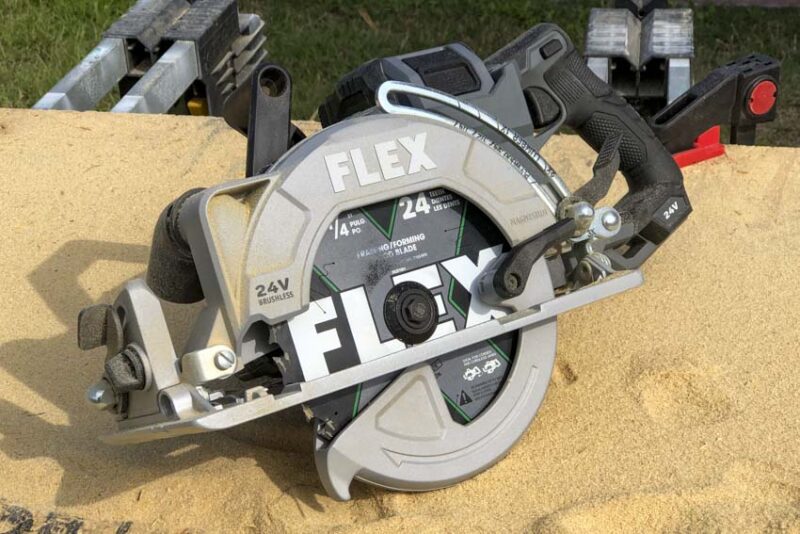
Flex and Milwaukee went toe-to-toe in a fight for the best worm drive/rear handle circular saw title and they were very close in the end. What pushed Flex over the top was its superior power. Both easily outstrip our top 15-amp corded model with impressive performance.
From a design standpoint, Flex put together a complete package. The ergonomics are right, the shoe glides across material easily, it tracks well, and it has a solid build. Toss in a 5-year warranty, and Flex makes for a very compelling option.
Price: $249 bare, $399 kit with a 10.0Ah Stacked Lithium battery and a charger
Want a corded model instead? We recommend the Skilsaw SPT77WML Lightweight Magnesium Worm Drive ($199 – $219).
Discover more cordless options in our Best Cordless Worm Drive and Rear Handle Circular Saw article!
Best Circular Saw for Cutting Metal
Milwaukee M18 Fuel Metal Cutting Saw
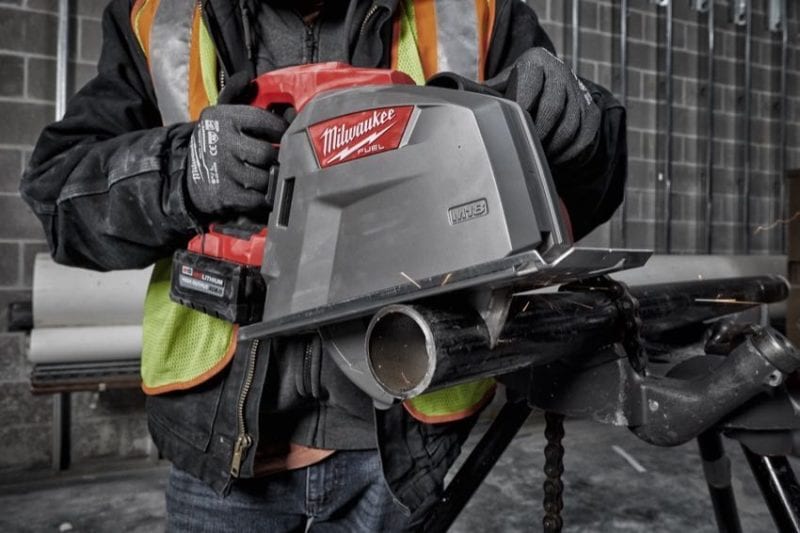
There are very few tools that earn a perfect score from our review team, but Milwaukee’s corded 8-inch metal cutting was one that did. So when Milwaukee launched an M18 Fuel version, we had high expectations, and the saw delivered. The performance is smooth and powerful, and the design was already field-proven in the corded version. If you’re on the hunt for the best circular saw for cutting metal, look no further than Milwaukee.
Price: $429 bare, $549 with an 8.0Ah High Output battery and charger
Want the corded version instead? It’s $399 at Acme Tools.
Best Compact Circular Saw
Flex 24V Brushless 6 1/2-Inch Inline Circular Saw FX2131A-1C
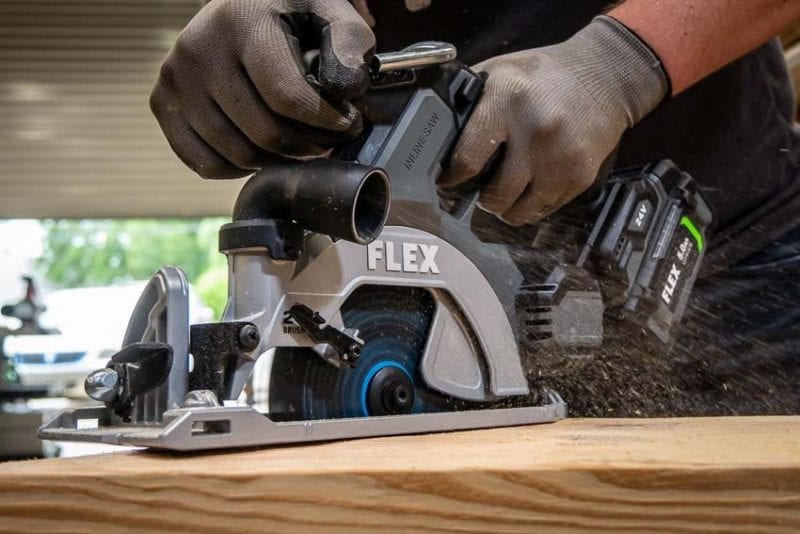
It was going to take something special to displace Makita’s XSH03 as our favorite in the compact category. Taking over as the best compact circular saw, the Flex 6 1/2-inch inline model most certainly is.
Underneath the inline handle design, there’s a belt drive connecting the brushless motor to the blade, giving it the cutting depth of a 7 1/4-inch saw even though it uses a 6 1/2-inch blade. Beyond that, this model does the best job of satisfying the blade viewing preferences of both blade-left and blade-right saws.
If you still need a nudge to pull the trigger, this saw has a 5-year warranty.
Price: $249 with a 5.0Ah battery and a charger
Need a corded recommendation? For under $90, it’s tough to beat Ridgid’s 6 1/2-inch compact magnesium circular saw!
Best Mini Circular Saw
Milwaukee M12 Fuel 5 3/8-Inch Circular Saw 2530
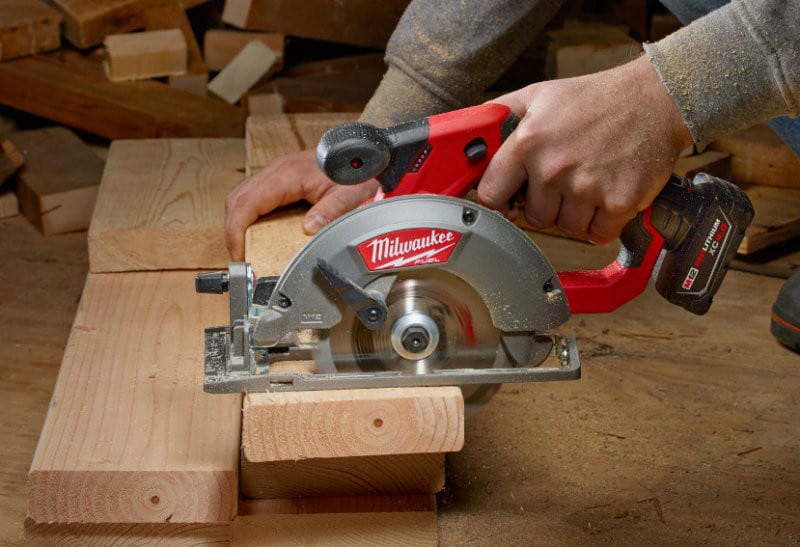
When it comes to getting even more compact than the 6 1/2-inch class, there are two distinct designs. One is to downsize a standard circular saw form factor. The other opts for an even smaller blade and an extended inline design. Between the two, we prefer the ergonomics and control of the traditional form.
The Milwaukee M12 Fuel 2530 earns our pick as the best mini circular saw thanks to its physical form, light weight (6.3 pounds with the battery), and of course, performance. Using an M12 battery for a power source, it’s significantly lighter than anything you’ll find on the M18 system and still has the capacity to cut through 2x material in a single pass.
Price: $149 bare, $249 kit with a 4.0Ah battery and charger
Want one of the inline mini circular saws instead? Skil’s PWRCore 20 4 1/2-inch model offers a lot of bang for your buck with a $129.99 price tag that includes the saw, battery, and charger.
Best Circular Saw for the Money
Skilsaw 15-Amp Lightweight Circular Saw SPT67WL/SPT67WM
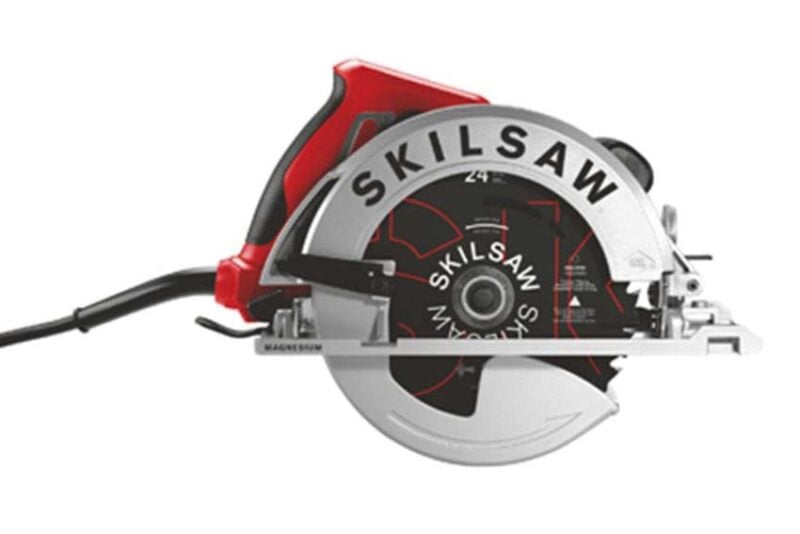
To get the best circular saw for the money, we’re leaning on corded models and looking for a legit Pro-grade option that’s less than $100. Fitting the bill is Skilsaw’s SPT67WL/SPT67WM. Available with either a Skilsaw or Diablo blade, these saws use magnesium to bring the overall weight down without sacrificing strength. They have the power of a 15-amp motor turning their blades at 5300 RPM. They’re not as strong as the 77-series models and they don’t include a blade brake, but for less than $100, you’ll have a hard time finding anything better for the price.
Price: $99.99
Want a cordless model instead? Grab Skil’s PWRCore 20 XP circular saw—the kit is $169 and includes everything you need to get started!
Best Circular Saw for Beginners
Skilsaw 15-Amp Circular Saw SPT67WE-01
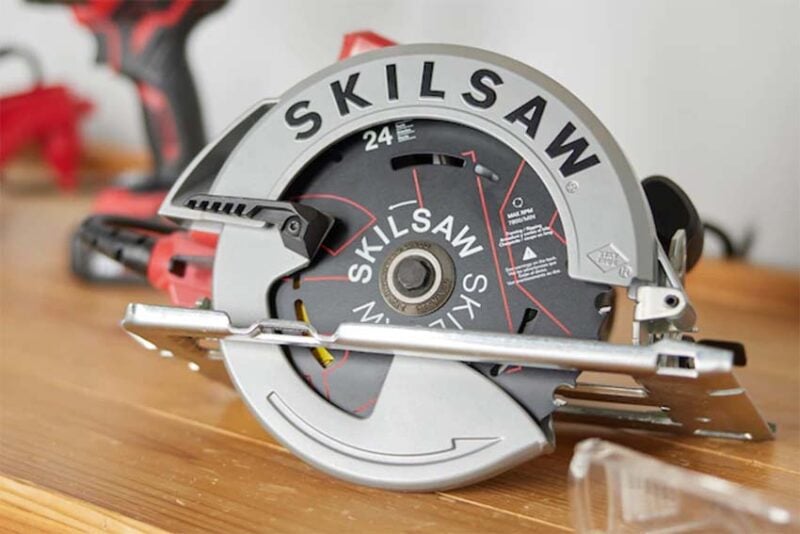
Just because you’re a beginner doesn’t mean you have to settle for a circular that’s cheaply built. You also don’t have to spend a ton to get a quality model. Sure, you may give up some top-end power and a few features, but starting with something that you think you might only need a couple of times a year may turn into a weekly passion for projects.
The Skilsaw SPT67WE-01 is a 15-amp circular saw featuring the same motor and performance as our Best for the Money pick. The big difference is that this model doesn’t use magnesium in the construction, so it’s not as light. At 10.3 pounds, it’s not exactly heavy, though.
There are less expensive circular saws you can get your hands on and they’ll cut just fine. However, it’s our opinion that beginners will get off to a better experience by bumping up the budget a little.
Price: $79
Best Circular Saw Blades
CMT Orange Tools Circular Saw Blades
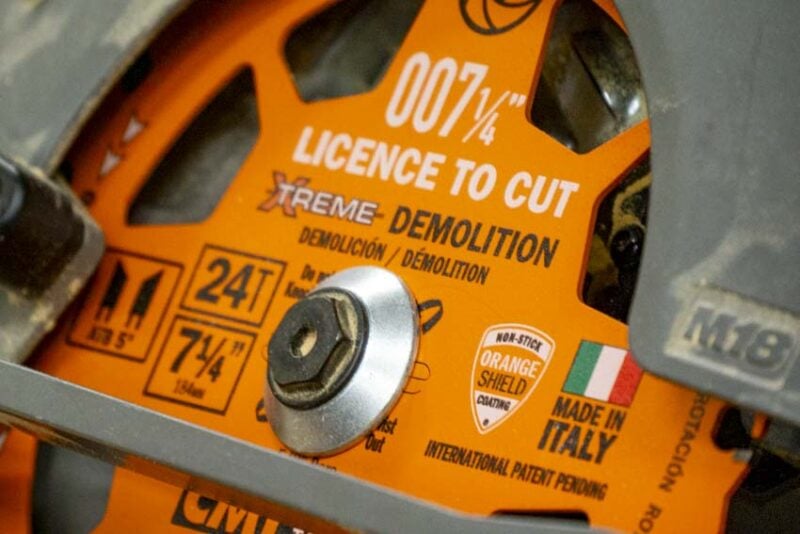
There’s a lot of competition for circular saw blades with plenty of genuinely great options. Crescent, Diablo, Makita, and Milwaukee all make blades we’ve used with excellent results and life. Two of our favorites right now come from CMT Orange Tools.
The 007 Licence to Cut is a solid choice as a demo blade for when there’s a chance you’re going to hit nails or other materials. Made with a lower mass and think kerf, it makes for fast, efficient cutting with both corded and cordless circular saws. Plus, its highly durable, deep-set teeth and narrow gaps hold up better when you’re making tough demo cuts.
Price: $124.99 10-pack
For a standard framing blade, it’s tough to beat the ITK Plus Fast Framing blades. Full-featured while using a thin kerf design that’s cordless friendly, a tough carbide for the teeth, and a geometry that improves cutting speed, it makes cutting clean wood a breeze.
Price: $89.99 10-pack
Best-Selling Circular Saws
Often, the best-selling circular saws strike a fantastic balance between performance, features, and price. In other words, they’re frequently an excellent value. Check out these options from top retailers and see if there’s something that suits your needs.
Amazon
- DeWalt 20V Max 6 1/2-inch Circular Saw DCS391B – $99.99
- Skil 15-Amp 7 1/4-Inch Circular Saw with Laser Guide 5280-01– $69.99
- Skil 13-Amp 7 1/4-inch Circular Saw 5080-01 – $39.99
Acme Tools
- Makita 18V X2 LXT 7 1/4-inch Circular Saw Kit XSH06PT – $399
- Milwaukee M18 Fuel 7 1/4-inch Circular Saw Bare Tool 2732-20 – $249
- DeWalt FlexVolt 60V Max 7 1/4-inch Circular Saw Kit DCS578X1 – $339
Home Depot
- Makita 18V X2 LXT Rear Handle Circular Saw Kit XSR01PT – $399
- DeWalt 20V Max Brushless 6 1/2-inch Circular Saw Bare Tool DCS565B – $199
- Ryobi 18V One+ HP Brushless 7 1/4-inch Circular Saw Bare Tool PBLCS300B – $139
Lowe’s
- DeWalt 20V Max XR Power Detect 7 1/4-inch Circular Saw Bare Tool DCS574B – $249
- Skil 13-Amp 7 1/4-inch CIrcular Saw 5080-01 – $45.99
- Craftsman V20 6 1/2-inch Circular Saw Bare Tool CMCS500B – $79
Best Circular Saws from Brands We Trust
Not every brand is represented in our top picks above, but there are still plenty of quality options for Pros, DIYers, and everyone in between. If none of those are quite what you’re looking for, check out these and see if there’s a better fit.
Best Circular Saws for Professional Use
Bosch 18V ProFactor Circular Saws
Bosch has both corded and cordless circular saws that are appropriate for Pro use. Look for the 18V ProFactor models to get outstanding cutting performance with cordless convenience. There are several models to choose from, all built on the same foundation. There’s a standard blade left (GKS18V-26) and a standard blade right (GKS18V-25), plus a track-compatible version of the blade right model (GKS18V-25GC). Both blade right models are also Bosch Connected-Ready. If we had to choose just one, it would be the track-compatible GKS18V-25GC.
Price: $289 bare, $449 kit with an 8.0Ah High Power battery and charger
DeWalt Lightweight Braking Circular Saw DWE575SB
DeWalt runs deep in the circular saw category in both corded and cordless power sources. The FlexVolt line has the best overall performance with both sidewinder (DCS578) and rear handle (DCS577) options, while the 20V Max Power Detect (DCS574) is a solid pick if you want to stick with 20V Max batteries. All of those are great choices, but it’s hard to ignore the value and quality of DeWalt’s corded DWE575SB. Using magnesium for the construction, it’s a lightweight 7 1/4-inch saw with an electric brake that’s been a proven workhorse on jobsites for years.
Price: $159
Flex 24V Brushless Circular Saw FX2141
In addition to the two excellent saws we recommended above, Flex also has a standard sidewinder-style model on the same battery platform. It’s solid in performance, keeping up with the best cordless models from the top professional brands.
Price: $199 bare, $299 kit with an 8.0Ah battery and charger, $399 with a 10.0Ah Stacked Lithium battery and charger
Hilti Nuron Metal Cutting Circular Saw SC 6ML-22
Hilti’s 22V Nuron battery platform has excellent options for a sidewinder (SC 30WR-22) and rear handle (SC 30WL-22) styles, but it’s their newest cordless metal cutting saw we’re most excited about. The lower-RPM cold-cutting design leaves little burring and creates few sparks while offering a significant boost in cutting power over the previous model.
Price: $310 bare tool
Kobalt Next-Gen 24V 6 1/2-Inch Circular Saw KCS 124B-03
As a value Pro brand, Kobalt has three primary circular saw options, and you really can’t go wrong with any of them. Their 15-amp K15CS-06AC is a solid value pick on the corded side, and the 24V XTR has excellent performance as their top-of-the-line cordless pick. Call us crazy, but it’s the next-generation 24V 6 1/2-inch circular saw we’d recommend for most people. It offers higher performance than the original 6 1/2-inch model while maintaining lighter weight and easier maneuverability than the XTR. Considering it can make 90° and 45° cuts in 2x material in one pass, it has the best balance of everything.
One thing to keep in mind is that this one is only available as a bare tool. However, Kobalt’s 24V system is one of the most affordable to get into, so look for a deal on some of their kits to get the battery and charger you need if you’re not already on the system.
Price: $129 bare tool
Makita 40V max XGT 6 1/2-Inch Circular Saw GSH05
Makita is another brand that runs deep in the circular saw category with options on their 12V CXT, 18V LXT, and 40V max XGT lines, plus some excellent corded models. Needless to say, deciding on just one is difficult. You might be surprised that our top pick is a 6 1/2-inch model but hear us out. Makita’s 40V max XGT compact circular saw is lighter and more maneuverable than most, making it an easy choice for those quick cuts you have to make throughout the day. Add in the higher performance, improved technology, and expanding scope of the 40V line, the capacity to cut 2x material at 90° and 45°, and AWS capability, and it’s a darn good compact saw.
Price: $269 bare, $469 kit with two 4.0Ah batteries and charger
Milwaukee M18 Fuel Circular Saw 2732
Milwaukee has a broad range of circular saws covering their M12 and M18 battery platforms, plus corded options and outstanding metal-cutting circular saws. For daily professional use, take your pick of the M18 Fuel 2732 if you prefer a sidewinder or the M18 Fuel 2830 if you like a rear handle design. Either way, you get a saw that outperforms Pro-level 15-amp corded models with an excellent design on a battery system that covers the needs of tradesmen and tradeswomen in ways no other brand does. If you asked us which one to choose, we like the sidewinder style 2732 better for the way we work.
2732 Price: $249 bare tool, $449 kit with a 12.0Ah High Performance battery and charger
2830 Price: $279 bare tool, $449 kit with a 12.0Ah High Performance battery and charger
Ridgid 18V Brushless Rear Handle Circular Saw R8658
Ridgid circular saws are popular due to their value pricing and ease of access at Home Depot. While there are corded and cordless options available, we recommend you go with the brushless rear handle for several reasons. First, it’s the highest-performing cordless model on Ridgid’s 18V platform and is the culmination of what the design team has learned over several generations of cordless circular saw design. Plus, the kit comes with Ridgid’s most advanced battery technology—EXP. But then there’s the Lifetime Service Agreement. As long as you register within 90 days, the tool and battery are covered for free, for life.
Price: $349 kit with an 8.0Ah EXP battery and charger
Best Circular Saws for Prosumer/Serious DIY Use
Craftsman V20 Brushless RP Circular Saw CMCS551
Craftsman has several circular saws to choose from and the choice boils down to the newer V20 Brushless CMCS551BLW for cordless or the 15-amp CMES510 for a corded option in our opinion. Now that Craftsman V20 brushless is a full-size 7 1/4-inch model with the power to take advantage of its 2 9/16-inch cutting depth, that’s what we prefer. The downside is that it’s only available as a bare tool, so you’ll need to grab a battery and charger if you’re not already on the Craftsman V20 system.
Price: $129 bare tool
Masterforce Boost 7 1/4-Inch Brushless Circular Saw 5415.1
If you’re a fan of Menard’s, then you’re certainly familiar with the Masterforce line of tools. While the majority of those tools are squarely in the DIY crosshairs, the newest Boost circular makes the jump in the Prosumer category. Sporting a brushless motor that works with all Masterforce 20V batteries, it jumps to a higher performance level when you pair it with a Boost battery. Additionally, Masterforce’s design uses more metal than most DIY models, with the shoe, blade cover, and blade guard all using metal in the construction, whereas much of the competition at least shifts the guard to plastic.
The downside is that this one only comes as a bare tool. However, Menards runs a lot of deals throughout the year, so keep your eyes open for sales and mail-in rebates that can help you jump onto the platform.
Price: $156.95
Ryobi 18V One+ 18V Brushless 7 1/4-Inch Circular Saw PBLCS300
For Ryobi, we recommend stepping all the way up to their flagship 7 1/4-inch HP Brushless model for the 18V One+ battery system. While the other saws in the line (and there are many) each have a purpose, the PBLCS300 offers the best overall cutting experience. From excellent power and thoughtful design to Ryobi’s high-value pricing, this is a highly approachable saw for folks who don’t have a Pro-level budget but still want solid performance.
Price: $139 bare tool, $199 kit with a 4.0Ah High Performance battery and charger
Skil PWRCore 20 XP Brushless Circular Saw CR5440B-10
While Skilsaw circular saws are the benchmark all other professional circular saws are measured by, the Skil side of the business covers Prosumer and DIY needs. For more serious enthusiasts, take a close look at what the Skil PWRCore 20 XP 7 1/4-inch circular saw offers. With higher performance than Skil’s other 20V sidewinder style models, it offers a lot of bang for your buck. One thing that sets this model apart from its competition is that Skil has a ready-made track specifically for this saw if you want to take your accuracy to the next level.
Price: $129 bare tool, $169.99 kit with a 4.0Ah battery and charger
Best Circular Saws for DIY and Home Use
Greenworks 24V Brushless 7 1/4-Inch Circular Saw 1503402
Chances are, you know Greenworks for its lawn care and landscaping tools, but they’ve also moved into the power tool sector with a line of handy cordless tools that work on the same battery as the 24V OPE. For a circular saw, you have a couple of options and our pick is the brushless 7 1/4-inch model. That brushless motor offers better performance, runtime, and life than DIY saws with brushed motors. It’s also a lightweight option. Right at 9 pounds with the 4.0Ah battery, it’s noticably lighter than the majority of 7 1/4-inch saws we’ve reviewed.
Price: $119.99 bare tool, $199.99 with a 4.0Ah battery and charger
HART 20V Brushless 7 1/4-Inch Circular Saw HPCS25
HART has a couple of DIY-focused circular saws we like, and it’s a toss-up between the lighter, more compact 6 1/2-inch and the higher performance of the brushless 7 1/4-inch. In this case, the larger saw is the way we’d go, though we wouldn’t blame you for a second if you lean the other way. Not only does it have the higher performance, runtime, and life of a brushless motor to go with a full-size cutting capacity, but recent rollback pricing has made it an outstanding value.
Price: $98 bare tool, $129 kit with a 4.0Ah battery and charger
What is a Circular Saw Used For?
As a saw, a circular saw is used for cutting material. The majority of models are for cutting wood, although there are options specifically for cutting metal. Because of the saw’s design to pivot laterally, it’s useful for making cross, rip, miter, bevel, and compound cuts.
Unlike a table saw where you push the material across while the blade is fixed, a circular saw works the opposite way. You glide the shoe across your material while the blade cuts through it. This makes it a popular choice for many types of cutting thanks to its high portability.
Many people cut freehand, watching the blade or indicator notches in the shoe as they follow their cutlines. To be more accurate, you can clamp a straight edge down or buy a third-party fence.
There are even add-on rail systems to make your circular saw work similar to a track saw. However, these usually aren’t as accurate as a true track saw. Likewise, it’s difficult to make miter, bevel, and compound cuts as accurately as the best miter saws.
Best Circular Saw Buying Guide – What We Look For
Cutting Power
RPMs are helpful but they aren’t everything when cutting. You need torque to help the blade keep its speed up in tough cuts. On the corded side, look for 15-amp motors to get the best performance. Cordless isn’t as easy to gauge, though. In general, look for a brushless motor to get the highest performance.
Either way, moving into the middle and high sections of the price range usually gets you into higher performance levels
Tracking
Some saws tend to have a slight turn to the left or right as you make long cuts. This could be from a damaged arbor, but most of the time we find it’s the handle design encouraging it. Even with saws that do, once you realize it’s a characteristic, you can usually slow down a bit and keep the blade right on your cutline.
Guard Action
Some guard designs can hang up on the edge of your material or on shave cuts where the waste material pushes inside the guard. The best circular saw guards glide up easily over every type of cut you make.
Dust and Chip Removal
Circular saws create a lot of sawdust and chips. Look for models that clear them well (higher RPMs help) through the dust port in the cover. If you do a lot of your work inside, look for a model that includes a dust port adapter so you can easily hook up your favorite shop vac to it.
Handle Ergonomics
As you’re trying different circular saws, consider how your grip feels on both the main and front handles. Overmold can help with comfort and security, and shape plays a big part. Also, consider how the handles feel together when you have both hands on the saw. Some may be too close or too far from each other for your comfort.
Weight
Weight isn’t a big consideration on circular saws. Because you cut with the weight on the saw on top of your material, it bears the brunt of it. However, lighter saws can be beneficial as you’re carrying them back and forth to where you’re cutting and as you transfer the weight to your arms at the end of each cut.
Price and Value
Once you know what your circular saw budget is, take a look at what is available at that price point. To get the best value, we recommend going with the best performance as the highest priority. Ergonomics and features still come into play, as does the warranty. If you’re shopping for a cordless model, consider what other tool work with the same battery.
Corded or Cordless?
15-amp corded circular saws have outstanding power and you can get a trusted professional brand name for $100 or less. Many of these saws can last a decade or more.
The major trade-off is that you’re going to need an extension cord and access to power.
There’s no denying the convenience of cordless circular as an easier way to cut. Most of the major brands now have cordless options that can meet or exceed the performance of a 15-amp corded model.
That only goes for the best cordless circular saws, though. Some compact and 12V saws are well under the 15-amp performance level. There are also DIY-focused brands that don’t have that strong of a saw in their portfolios yet.
There’s also cost to consider. Cordless tools are more expensive by the time you add the cost of a battery and charger. The batteries need to be replaced every 3 – 5 years and they’re not cheap. Corded models tend to be far less expensive, and a high-end one can cost less than a mediocre cordless saw.
Blade Left or Blade Right?
Whether you prefer the blade on the left side of the motor or the right boils down to more than just being left or right-handed. There’s what feels the most natural to you as well. See if you can give both styles a shot in the store and decide which one works best for you. Read more about those considerations here.
Sidewinder or Worm Drive?
The circular saw design preference is surprisingly regional with the West Coast trending towards rear-handle worm drives and the East Coast primarily using sidewinder direct drives.
Worm drives tend to have a more inline handle design and weigh more. The worm drive gearing that gives the saw its name produces more torque than the same motor in a direct drive. It’s enough extra power that these saws almost always require you to punch out the diamond knockout on your blade to use its more secure arbor.
Sidewinders are usually lighter than worm drives with a more compact design. The handles can be inline but are frequently offset somewhat. With less torque than worm drives, you don’t remove the knockout for their round arbors.
Blade Size
The most common blade sizes for circular saws are 6 1/2 inches and 7 1/4 inches. These are both capable of cutting 2x material in a single pass and are appropriate for everyday use.
Bigger blades require more power to keep RPMs high enough, so 6 1/2-inch saws nearly always have less power than a 7 1/4-inch model.
However, there are also several models that take 10 1/4-inch blades and can cut 4x material in one pass. There are even saws that take a blade over 16 inches that timber framers use!
Moving smaller and more compact, you can find models that take 5 3/8-inch blades and even 4 1/2-inch blades like the DeWalt Atomic.
The trick to finding the best circular saw blade size for you is to check the maximum depth of cut at 90º and 45º. You can find that in the specifications online or in the manual. As long as it can cut the depth you need, you’re good to go.
If you’re not sure where to start, look for something that can cut through 2x material. 2x dimensional lumber is 1 1/2 inches thick. The majority of circular saw cuts our team makes are on 2x and sheet goods. However, keep in mind that smaller saws have less power.
Why You Can Trust Pro Tool Reviews
Ever check out a “review” site and you can’t tell if they actually tested the tools or if they’re just “recommending” the Amazon top sellers?
That’s not us. We only recommend what we’d actually use, even if we don’t earn a commission from it. It’s all about giving you a legitimate recommendation and our honest opinion of each product.
We’ve been in business since 2008 covering tools, writing reviews, and reporting on industry news in the construction, automotive, and lawn care industries. Our Pro reviewers work in the trades and have the skills and experience to know whether tools can perform well in the field.
Each year, we bring in and review more than 250 individual products. Our team will put our hands on hundreds of additional tools at media events and trade shows throughout the year.
We consult with innovators in the technology and design of tools to gain a broader grasp of where these products fit and how they work.
We’ve worked with more than two dozen professional contractors around the United States who review products for us on real job sites and consult with us on testing methods, categories, and weighting.



